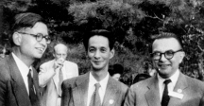Speaker
Description
Abstract: A massive star ends its life as a violent supernova explosion. The compact core left over could form an ultra-dense object called a neutron star. Neutron stars are more massive than the Sun but as small as a city, and they possess the strongest magnetic field in the Universe. These remarkable properties make them ideal laboratories for studying physics under extreme conditions. Since the first pulsar was discovered in the 1960s, all neutron stars were thought to spin rapidly and emit broadband radiation. However, the emergence of different populations, including magnetars, dim isolated neutron stars, central compact objects, and millisecond pulsars, over the past decades has revolutionized this simple picture. In this talk, I will describe the diverse properties of the neutron star populations and highlight some recent results from multi-wavelength studies. I will also discuss attempts to unify different classes of objects.

